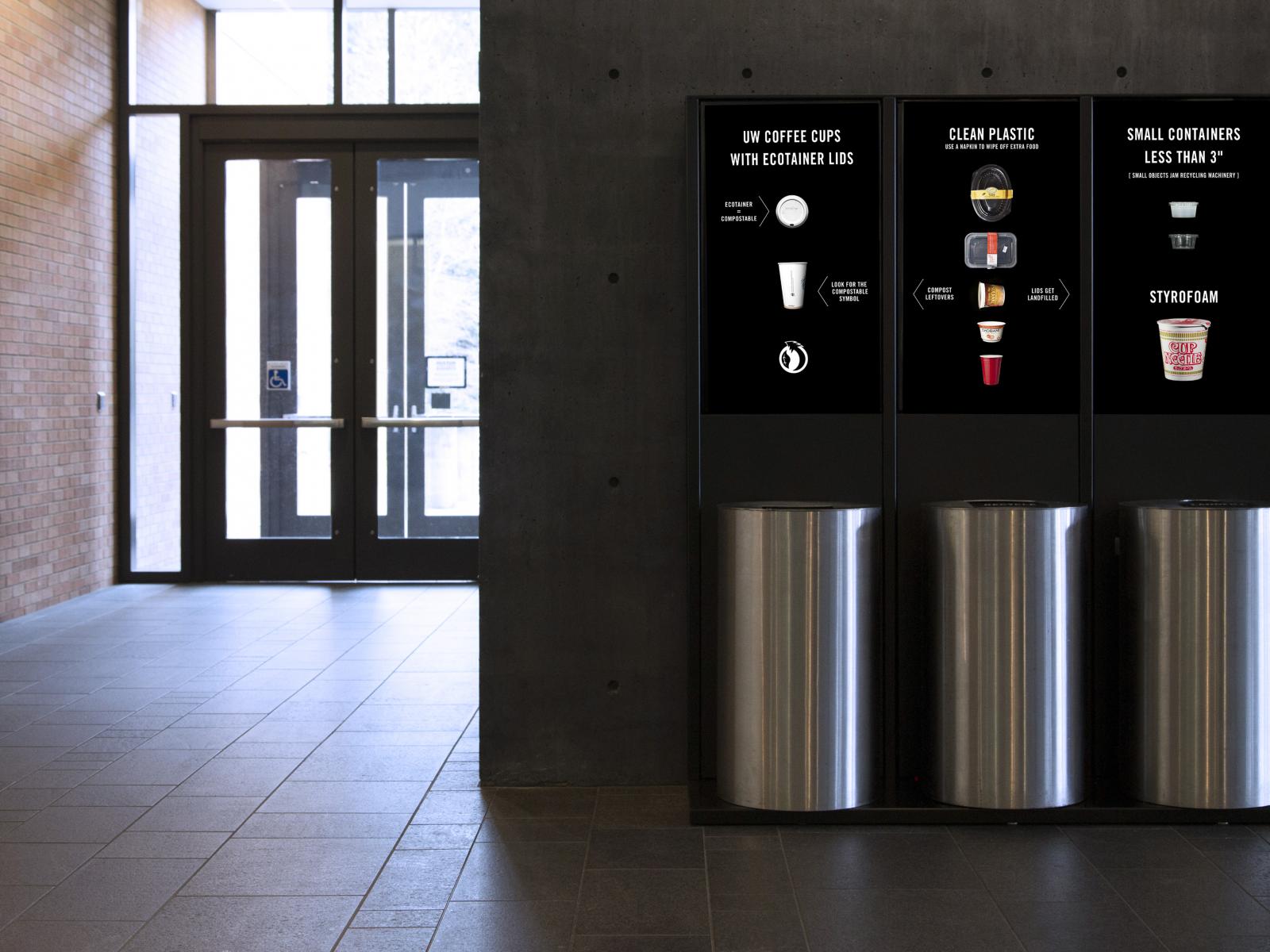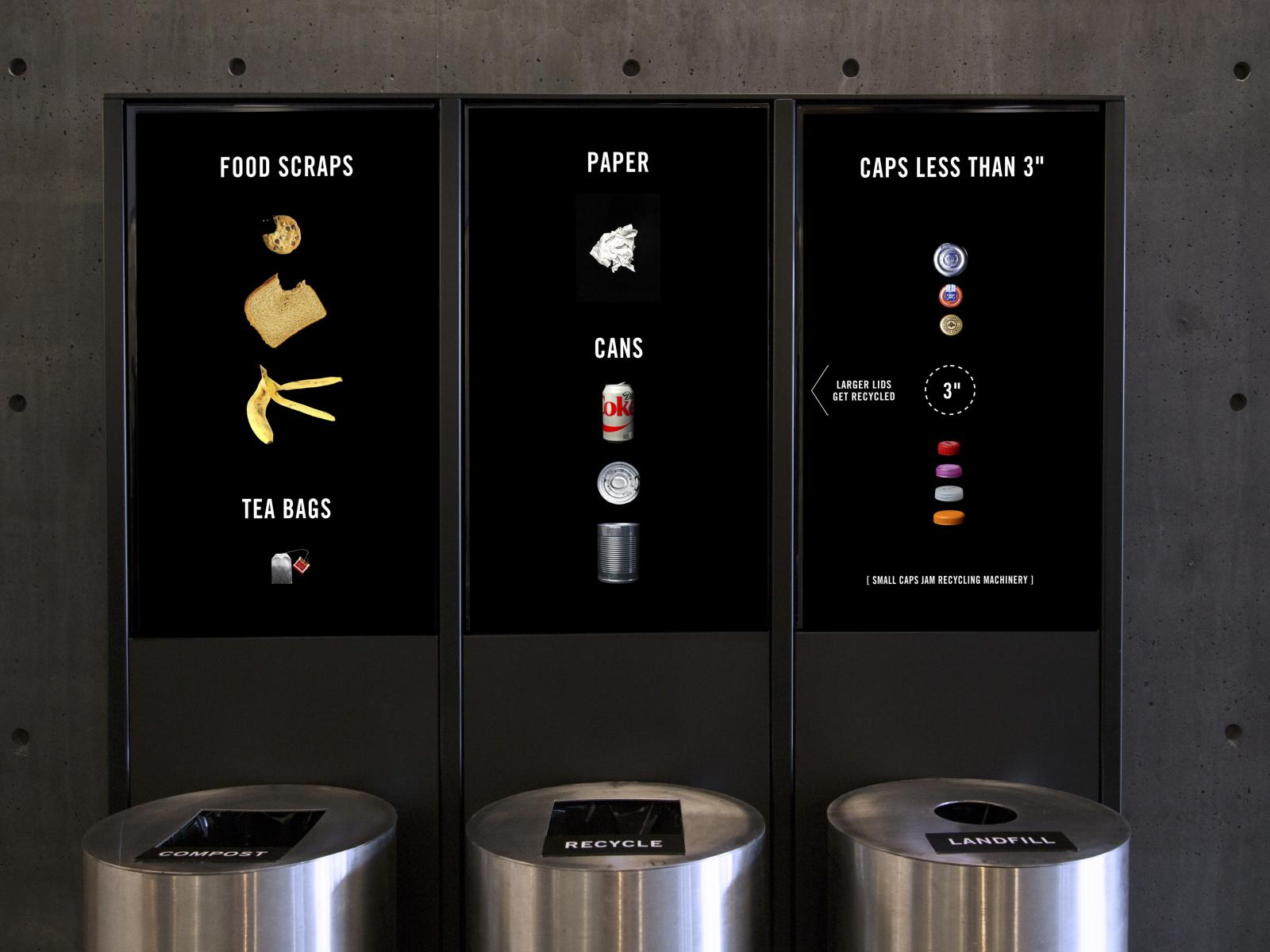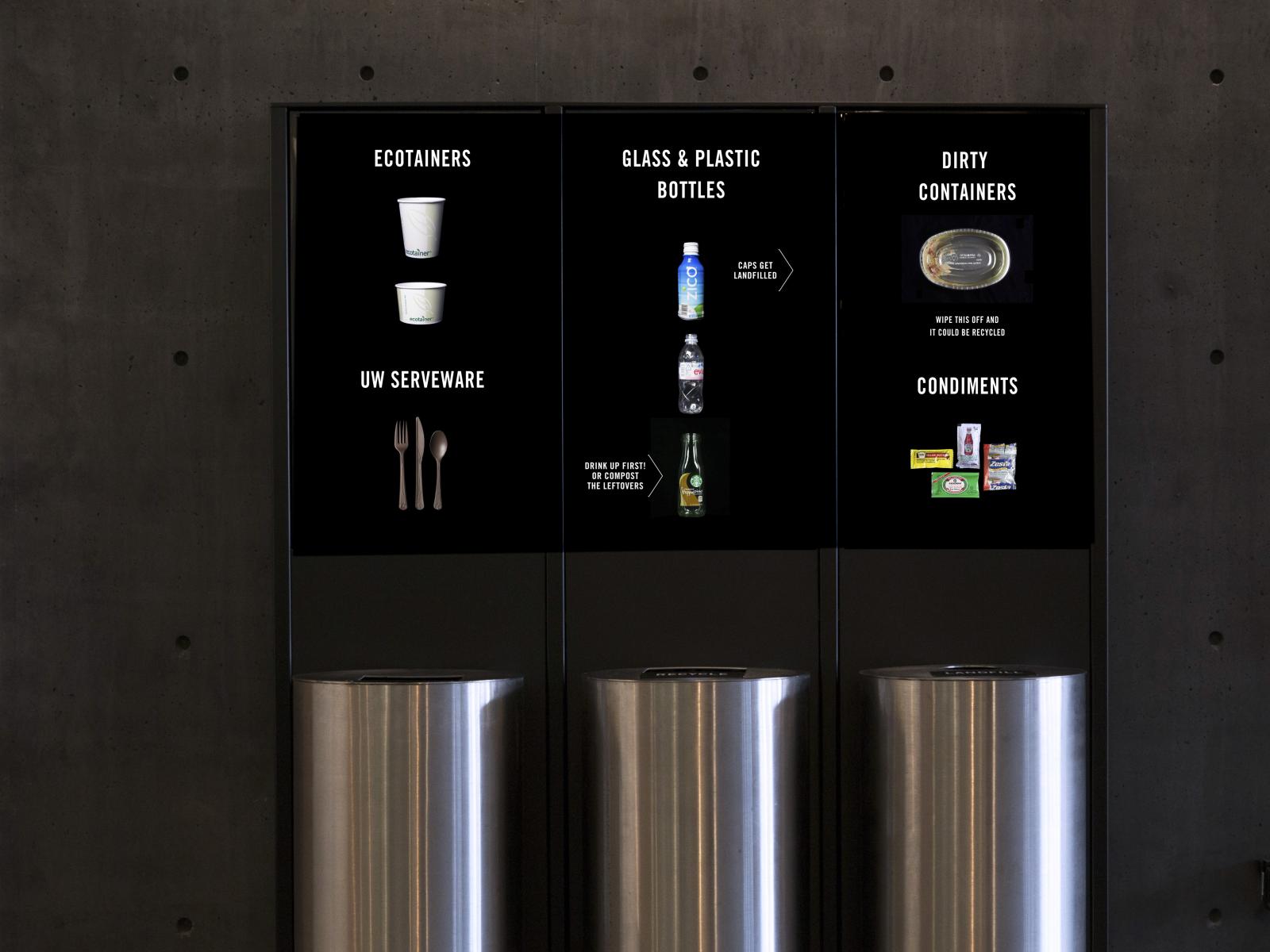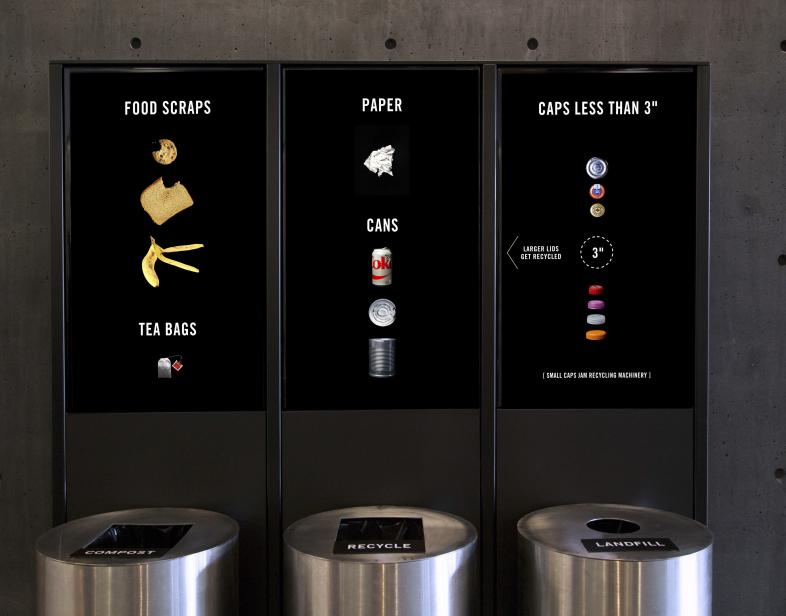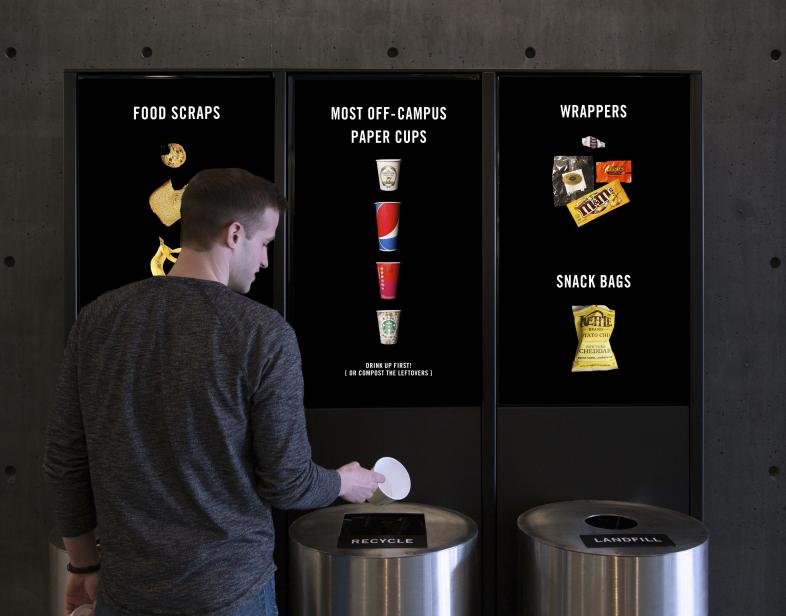An Overview Of Our Solution
Every day, the average American produces 4.5 pounds of trash. More than 70% of that waste could be recycled or composted—
but most of it goes to landfill. Landfills are the 3rd largest source of methane, a powerful greenhouse.
Why don’t people compost and recycle? Many say they are willing to do so—but they forget to make the effort, or they are confused about what goes where.
To address this problem, our team developed “Smart Bins.” Each Smart Bin has a scale, micrcomputer and digital screen. When users throw away their waste, the bins respond with positive messages. When not in use, the screens show fun videos about waste.
In 2016, the UW Garbology Project measured the impact of Smart Bins. Smart Bins increased composting by 20%, decreased recycling contamination by 15%, and decreased landfill by 5%.
Please see: http://vimeo.com/183034021
- Population Impacted: Varies; at UW ~60K
- Continent: North America
Context Analysis
The US EPA has shown that significant greenhouse gas emissions could be avoided if more people would compost and recycle. Unfortunately, many individuals fail to do so. At the University of Washington, results from a 2012 trash sort found that 88% of a landfill bin could have been composted or recycled—even though three bins were co-located.
Why don’t people compost and recycle? Research suggests that for some, proper waste disposal is simply not a priority (Martin, Williams Clark, 2006). Others are willing, but are lack knowledge (Kaplowitz, Yeboah, Thorp, Wilson, 2009)
Research shows that non-recyclers are motivated to change their behavior when: 1) they feel social pressure to participate or 2) they receive personalized feedback on their recycling (Folz, 1999). Studies also find that educational materials need to be visually com¬pelling and located in close proximity to the disposal point to be effective (Dahle and Neumayer, 2001; Thomas, 2001).
Describe the technical solution you wanted the target audience to adopt
When users place their waste item into a bin, they see one of thirty different on-screen messages.
These messages are updated every quarter. Message types include:
1) Rewards for positive behavior—messages that congratulate users for composting or recycling their waste.
2) Education for users —for example, we show that aluminum cans can be recycled endlessly,
without degradation/down-cycling.
3) Corrective messages—for example, messages that remind users that plastic containers must be “clean and dry” in order to be recycled.
4) Peer norm information—messages that show that others (a majority) are making the effort to recycling and compost their waste.
5) Suggestions for other waste-reducing behaviors—for example, messages that encourage users to bring their own mug or thermos.
Please see message examples here:
https://www.flickr.com/photos/85594841@N00/albums/72157669594675098
Type of intervention
Describe your behavioral intervention
We are trying to encourage users to take the time to sort their waste correctly—into recycling, compost and landfill bins.
First, we capture the user’s interest by showing an engaging, visually unique video at the point of disposal:
http://evoeco.com/assets/images/evobin/seattle_vids.mp4
Then, we reward users for correctly disposing of their waste by giving them positive feedback when they dispose of waste:
https://www.flickr.com/photos/85594841@N00/40655819950/in/album-7215766…
We educate users (with humor) when they dispose of items incorrectly:
https://www.flickr.com/photos/85594841@N00/27593976367/in/album-7215766…
We also seek to establish social norms by showing that others are also making an effort to compost and recycle:
For example, one alert shows:
"Congratulations! During April, you and your peers composted 432 pounds. Together, you offset emissions from 466 car miles."
As needed, please explain the type of intervention in more detail
This video shows our initial bin prototype: http://vimeo.com/183034021
Note: This video shows a single on-screen message, but we have a variety of messages that users see.
Describe your implementation
Our initial design team consisted of two design faculty members, two current design students, and two design student graduates/alumni. We outsourced our programming to a professional developer and worked with a local design-build vendor to specify and fabricate the first Smart Bins.
Prior to designing the looping video and user messages, we consulted with the head of UW Recycling and the head of the UW Garbology Project, both of whom shared existing research and personal knowledge on improper waste disposal. Additionally, we collaborated with a third faculty member (a user research specialist) who helped us design and conduct an intercept and interview study, where we tested UW citizens on their waste disposal knowledge. We also met with custodians and the building administrators to learn from their waste experiences, and to optimize the service design of the physical bins. In combination with a thorough literature search, this information and input was invaluable in determining which waste items to show and explain on the Smart Bins, and how to construct the receptacles.
After installation, researchers from the UW Garbology Project conducted 4 pre-installation and 5 post-installation trash sorts, and found that Smart Bins increased composting by 20%, and decreased recycling contamination by 15%. If Smart Bins were in use throughout campus, the university could increase its overall diversion from landfill by 8%—a substantial environmental impact.
External connections
Since the success of the initial pilot, we have been collaborating with EvoEco, an environmental startup,
to produce, manufacture and install Smart Bins throughout the US. New sets of Smart Bins have been successfully installed at multiple locations in San Francisco, Seattle and New York; we are seeking funding to expand to additional venues. We are also working to further develop the capacities of Smart Bins. Of note,
we are developing artificial intelligence software that works with built-in cameras to recognize the items that users throw away. We are also exploring how to integrate touch-screens to provide additional information and engagement.
The purpose of Smart Bins—enabling users to correctly dispose of their waste—aligns with the mission of zero-waste organizations, municipal waste departments and waste disposal firms such as Recology and Waste Management. Due to China’s recent “National Sword” policy, the waste disposal industry is eager to find ways to prevent recycling contamination.
Similarly, we hope to collaborate with anti-plastic organizations (such as the Plastic Pollution Coalition, Surfrider Foundation and the Ocean Conservancy) to incorporate their educational messages on our platform.
Who adopted the desired behaviors and to what degree?
The UW Garbology Project is a team of students from the Anthropology; these students conducted 9 trash sorts pre- and post-installation for Smart Bins at a campus café.
During pre-installation, contamination levels were:
Landfill: 75%
Recycle: 67%
Compost: 11%
After the installation was turned on, recycling contamination decreased from 67% to 54%. Based on intercept interviews, many users learned (via the installation) how to correctly dispose of compostable, plant-based plastic (PLA). There was no statistically significant change in contamination to Compost or Landfill.
Additionally, prior to the installation, compost averaged 10 pounds per day. After the installation, compost averaged 14 pounds per day. At the same time, the weight of recycling and landfill declined. Therefore, at Smart Bins, people landfilled and recycled less—because they moved their food waste and compostable packaging to the compost bin.
How did you impact natural resource use and greenhouse gas emissions?
When people recycle and compost instead of landfill, landfill gas (LFG) emissions are reduced. According to the EPA, LFG is composed of roughly 50 percent methane (the primary component of natural gas), 50 percent carbon dioxide (CO2) and a small amount of non-methane organic compounds. Methane is a potent greenhouse gas 28 to 36 times more effective than CO2 at trapping heat in the atmosphere over a 100-year period, per the latest Intergovernmental Panel on Climate Change (IPCC) assessment report (AR5).
The Garbology sorting procedure involves weighing each day’s trash, then correctly sorting that waste into compost, recycle and landfill. Each trash item is evaluated. For example, discarded cartons are opened so that interior items—food waste, plastic forks, napkins—can be extracted and weighed. In bottles, excess liquids are also weighed and counted.
What were some of the resulting co-benefits?
As a side note, we have observed that researching, designing and developing a recycling and composting project engages and informs all participants. For example, in her final project report, an undergraduate student Garbologist described her experience of a trash sort in this way:
“I couldn't believe that people could be so lazy, or in such a hurry, that they couldn't throw away even
a simple water bottle correctly. I know I've been guilty of doing that myself. But ever since starting this study, I've consciously made an effort to recycle, compost and landfill things the right way.”
Sustainability
In markets that incentivize recycling and composting, Smart Bins are self-sustaining, because they can provide a positive return on investment. For example, in San Francisco, waste haulers perform spot-checks. If recycling or compost is contaminated, clients pay a fine, and lose their billing credit for having a recycling/composting program.
There are also many markets (including Seattle) where the cost of landfill is substantially more than the cost of recycling or composting. In these markets, diverting waste from landfill creates a financial savings. For example, if the University of Washington had 100% correct waste sorting on the Seattle campus, they could save ~$290,700 each year.
Return on investment
At this time, EvoEco is able to manufacture one Smart Bin for ~$2.5K each—which is less than many non-digital waste receptacles. Customizing videos and on-screen messages is optional; this requires additional time and funding from the purchaser. The initial Smart Bins prototype was substantially more expensive. This initial prototype was supported by a $40K internal grant from the University of Washington. However, this funding included costs for one-time research activities (supplies for trash sorts, participant incentives, video recording, etc.) and one-time design expenditures.
How could we successfully replicate this solution elsewhere?
We hope to replicate this solution in multiple locations and venues—the Smart Bins are mobile and customizable.
For example, we have been approached by schools and non-profit organizations who wish to use Smart Bins as part of their Earth Day or environmental education units; these clients have asked if we can provide multiple language translations in custom videos.
There have been previous efforts by artists and researchers to make interactive waste bins
These efforts have often been interesting and provocative, but then have tended to be temporary, single-site installations.
In order to achieve scale, our partner startup (EvoEco) needs venture capital funding to support manufacturing, sales
and product development.
